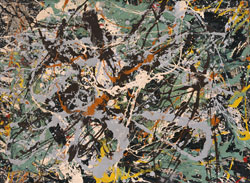Artist
Jackson Pollock Untitled (Green Silver) c.1949

Jackson POLLOCK
American 1912–56
Untitled (Green Silver) c. 1949
enamel and aluminium paint on paper, mounted on canvas
57.8 x 78.1 cm
Solomon R. Guggenheim Museum, New York
Gift, Sylvia and Joseph Slifka
© Jackson Pollock/ARS, New York. Licensed by VISCOPY Australia
2004.63
"The modern painter cannot express his age, the airplane, the atom bomb, the radio, in the old forms of the Renaissance or of any other past culture. Each age finds its own technique."
Jackson Pollock, born America 1912
Many Australians were introduced to Jackson Pollock’s work by the controversy surrounding the Australian Government’s purchase of his work, Blue Poles, Number 11, 1952. Blue Poles exemplified his signature drip-painting style. The picture shown here, Untitled (Green Silver) c. 1949 is one of his smaller works, produced partly because they attracted sales more readily than his large-scale canvases.
1949 was a big year for Pollock’s celebrity status as an artist. In 1949, Time Magazine asked of Jackson Pollock ‘Is he the greatest living painter in the United States?’ What started out as a slightly contemptuous investigation, referring to his technique as ‘drools’ and ‘doodling’, was soon taken seriously in the art world and beyond.
Untitled (Green Silver) c. 1949 is made from enamel and aluminium paint on paper fused to canvas. Pollock often tacked his canvases onto the floor in an approach he likened to that of the Navajo sand painters. Pollock explained that:
"On the floor I am more at ease. I feel nearer, more a part of the painting, since this way I can walk around it, work from the four sides and literally be in the painting".
Materials and Techniques
Pollock did not produce preparatory drawings, colour sketches or other plans for his work. After long deliberation before the empty canvas, he used his entire body in the picture-making process, as he dripped, poured and splattered commercial paint – including Duco (automotive paint) acrylic and aluminium – across its surface with the aid of sticks, hardened brushes and garden trowels. In Pollock’s classic poured paintings, line no longer serves to describe shape or enclose form, but exists as an autonomous event, charting the movements of the artist’s body. As the line thins and thickens, it speeds and slows. Its appearance is modified by chance behaviour of the medium such as bleeding, pooling or blistering. In short, Pollock broke free from the conventions and tools of traditional easel painting.
Susan Davidson has written about the intense period between 1947 and 1950 when Pollock made Untitled (Green Silver).
"Here, not only did Pollock move away from a reliance on traditional figuration and subject matter, but he broke free from the standard use of drawing and painting implements, usually abandoning their direct contact with the surface. Instead he worked from distances above the picture plane, using dripping, pouring, and splattering techniques – methods that were not necessarily Pollock’s invention alone but that he pushed to new extremes."
